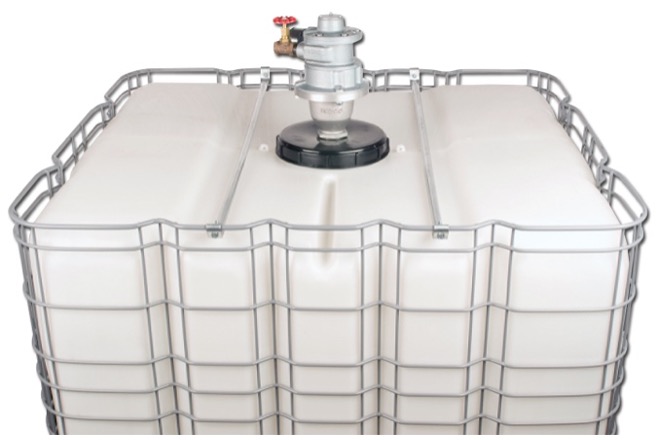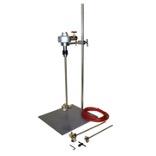Pneumatic vs Electric Industrial Mixing Equipment Considerations

One frequent request of INDCO’s mixer engineers is to explain the differences between electrically and pneumatically powered industrial mixers and which is the best option as both power sources are common in many production facilities. If you are looking to make an investment into new mixing equipment, you will need to make the choice between pneumatic and electric power, so let’s take a closer look at the top considerations you should keep in mind.
Where to Begin
The first step is to determine the specific details for each available utility. For electrical power this the voltage and phase at a minimum and verification that the circuit amperage capacity is sufficient is also advised. The most common electric power sources are 120/230V, single phase such as from standard wall outlets and a variety of higher voltages utilizing three-phase power such as 230/460V three-phase. Pneumatic power systems are driven by compressors delivering airflow via sealed pipe networks. If air power is preferred then the compressor output, i.e., volumetric flow rate and pressure (expressed as “x GPM @ y PSI”), should be determined. Furthermore, long piping runs or simultaneous use of the system to drive additional equipment reduces available power at the point of use. Before selecting an air-powered industrial mixer it is important to verify that the compressed air system can drive the subject pneumatic motor as air motors require significant volume.
There are additional factors that can also drive decisions. Some are inherent to how each motor type performs, and others are related to cost, operational differences and even environment and safety. The following are some examples of things to consider:
The Cost of Electric vs Pneumatic Mixing Equipment
Acquisition costs of air-driven mixers and single-speed electric mixers are usually comparable for portable mixers or those designed for mixing in containers from laboratory size to 250 gallons. Operating costs of pneumatic motors for batch sizes much larger than this becomes less feasible as air volume requirements and electricity cost for the compressor increase dramatically. Since pneumatic mixers are controlled by an air valve variable speed is essentially an included feature whereas variable speed control for electric mixers requires the addition of a DC motor control or a variable frequency drive (VFD) which increases cost. Therefore, when speed control is a must, electric mixers are more expensive than a similar powered pneumatic version.
Operational Differences Between Electric and Pneumatic Mixing Equipment
The torque vs. speed profile of the mixer can be very important. Single-speed direct-drive electric mixers are suited specifically for light liquids or lower-viscosity formulations. As liquid density or viscosity is increased a corresponding need for higher torque results. Improperly selecting an under-powered electric direct-drive mixer will result in the motor overheating and eventual equipment failure. A pneumatic direct-drive mixer has the advantage that motor failure will not result from overloading as it will simply stall under the load. It is important to note, however, that pneumatic motors do not reach a steady torque output until they are turning several hundred rpm. This may be a limiting consideration if running a product at very low shaft rpm is desired. In both circumstances torque is increased and the ability to run at lower speeds is achieved by adding a gear reducer. To push higher viscosity liquids gear-driven mixers feature larger shaft diameters and larger mixing impellers than direct drive models. For variable speed electric mixers DC motors are paired with DC motor controls as these motors provide greater torque output than the AC motors used on most single-speed units. The motor control rectifies the AC current provided by a standard 120V outlet for fractional horsepower motors. 
Safety and Environmental Considerations for Pneumatic and Electric Mixing Equipment
Mixer operational characteristics as described above may drive selection based on the likelihood of achieving a successful process. However, environmental and safety considerations are a frequent reason for selection of one or the other as well. For hazardous environments due to combustible ingredients, environmental gases, vapors or dust, pneumatic mixers are often selected since they are considered inherently safe, (i.e., they do not present an ignition source via a spark.) In these environments acquisition cost of the mixer is much lower than electric versions that are designed for hazardous environments. Electric motors for these environments are higher priced, heavier and require installation by a certified electrician. Furthermore, if variable speed is desired the control is placed outside of the hazardous environment adding further to the cost and complexity of the equipment setup. Although “explosion-proof” motor controls or VFD’s are available they are very expensive. Finally, if multiple mixers are to be utilized in a production area noise should be considered. Pneumatic motors are simply loud, especially when equipped with standard mufflers at the motor exhaust. High performance mufflers are available and make a significant difference, but air powered industrial mixers are generally still louder than electric mixers.

 Choosing the Right Pneumatic or Electric Mixing Equipment
Choosing the Right Pneumatic or Electric Mixing Equipment
INDCO supplies mixers for liquid processing for many industries and an almost countless number of individual applications. Paint and coatings, chemicals, wholesale food production, oil and gas and adhesives are just a few that use INDCO industrial mixing equipment to produce a product. Others, such as the water and wastewater treatment industries employ mixers in continual process applications. Electric mixers such as the versatile INDCO model HSM-03V can handle a variety of tasks and is commonly the choice for blending printing inks of extremely high viscosities. The high torque of the DC motor paired with variable speed control allows the mixer to operate at very low initial speeds then increase to facilitate heavier or thicker liquids. Air-powered stirrer packages such as the model ILS-2000X are often selected for pigment addition to small batch paint industry applications due to its inherent safety relative to flammability when solvent-based formulations are involved. This model is specifically suited for medium viscosity formulations in containers up to 5 gallons. For IBC totes, INDCO’s TL-11A and TL-050T mixers are air-powered and electric powered favorites, respectively.
Find the Right Pneumatic or Electric Mixer with INDCO
Whether you need help determining if pneumatic vs electric mixers are right for your processing needs or are ready to equip your operations with custom mixing equipment designed to optimize your process, our team of friendly and experienced customer service representatives and engineers are ready to work with you. Contact us or give us a call at 800-851-1049 to get started today. Shop the entire line of INDCO industrial mixer technologies.
